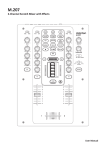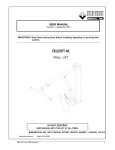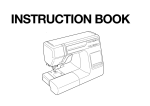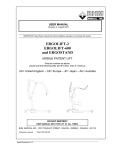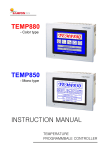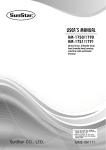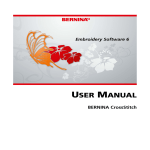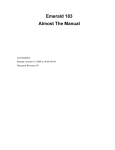Download Singer White Speedylock 1634
Transcript
C-) a) I m 0 C) C p D CD CD E z -I m I- C z z 0 -I C-) c Cl) z TABLE OF CONTENTS NAME OF MAIN COMPONENTS SETTONG UP YOUR MACHINE The position of thread pole Cone holders Spool caps Connecting the foot control Controlling sewing speed Safety switch Attaching the waste catcher ACCESSORIES USING THE MACHINE Hand wheel Front cover Free arm LOOPER THREADING NEEDLE THREADING TRIAL SEWING ADJUSTING THREAD TENSIONS Adjusting the needle thread tensions Adjusting the looper thread tensions MACHINE ADJUSTMENT CHART CHANGING THE THREAD BUILT-IN POCKET HANDLE ADJUSTMENT OF STITICH LENGTH Stitch length setting CUTTING WIDTH The proper cutting width Adjust to a wider cutting width Adjust to a narrower cutting width CHANGING THE NEEDLE REPLACING THE BULB REPLACING THE CUTTERS THREE THREAD NARROW AND WIDE OVERLOCK STITCH FREE ARM SEWING CONVERTIBLE PRESSER FOOT ROLLED AND NARROW EDGE Rolled edge Narrow edge Rolled hemming Narrow hemming DIFFERENTIAL FEED Differential feed mechanism Adjusting the differential feed Wavy knits & Gathering Stretching to prevent puckering TROUBLE SHOOTING GUIDE CLEANING AND LUBRICATING SPECIFICATION OF MACHINE 4-5 6-8 6 6 6 7 7 7 8 8 9 9 9 9 10 11 12 13-14 14 14 15 16 16 17 17 18 18 18 18 19 19 20 21 22 22 23-24 23 23 24 24 25-26 25 25 26 26 27 28 28 . IMPORTANT SAFETY INSTRUCTIONS When using an electrical appliance, basic safety precautions should always be followed, including the following: Read all instructions before using (this sewing machine) DANGER To reduce the risk of electric shock: An appliance should never be left unattended when plugged in. Always unplug this appliance from the electric outlet immediately after using and before cleaning. Always unplug before relamping, Replace bulb with same type rated 15 watts. WARNING To reduce the risk of burns, fire, electric shock, or injury to persons: Operate sewing machine only when mounted in sewing machine table, case, and the like. See the installation instructions. 1. Do not allow to be used as a toy. Close attention is necessary when this appliance is used by or near children. 2. Use this appliance only for its intended use as described in this manual. Use only attachments recommended by the manufacturer as contained in this manual. 3. Never operate this appliance if it has a damaged cord or plug, if it is not working properly, if it has been dropped or damaged, or dropped into water, Return the appliance to the nearest authorized dealer or service center for examination, repair, electrical or mechanical adjustment. 4. Never operate the appliance with any air openings blocked, Keep ventilation openings of the sewing machine and foot controller free from the accumulation of lint, dust, and loose cloth. 5. Never drop or insert any object into any opening. 6. Do not use outdoors. 7. Do not operate where aerosol (spray) products are being used or where oxygen is being administered. 8. To disconnect, turn all controls to the off (“0”) position, then remove plug from outlet. 9. Do not unplug by pulling on cord. To unplug, grasp the plug, not the cord. 10. Keep fingers away from all moving parts. Special care is required around the sewing machine needle. 11. Always use the proper needle plate. The wrong plate can cause the needle to break. 12. Do not use bent needles. 13. Do not pull or push fabric while stitching. It may deflect the needle causing it to break. 14. Unplug the sewing machine when making any adjustments in the needle area, such as threading needle, changing needle, changing presser foot, etc. 15. Always unplug sewing machine from the electrical outlet when removing covers, lubricating, or when making any other user servicing adjustments mentioned in the instruction manual. SAVE THESE INSTRUCTIONS INTRODUCTION THANK YOU FOR CHOOSING OUR OVERLOCK MACHINE — This overlock machine can stitch dependable seams on all kinds of fabric, both light and heavy, including cotton, wool, rayon, tricot, jersey, and knits. You do not need a special table for this portable machine. We suggest that you read this instruction manual carefully before you start to operate the machine. FOR YOUR SAFETY 1. Keep your eyes on the needles when operating the overlock machine. Do not touch the handwheel, the cutter or the needles when the machine is running. 2. Turn off the power switch, and pull out the plug from electric socket in the following cases: * When you have finished your sewing. * When you leave the serger temporarily. * When replacing the parts. * When cleaning and adjusting the machine. BEFORE YOU USE 1. Wipe dust and oil off the machine to avoid any stains on the sewing materials. 2. Test sew by using the same sewing materials you intend to sew. 3. Read this instruction manual thoroughly before replacing the cutters and the needles. Follow the instructions for correct replacements and adjustments. TABLE OF CONTENTS NAME OF MAIN COMPONENTS SETTONG UP YOUR MACHINE The position of thread pole Cone holders Spool caps Connecting the foot control Controlling sewing speed Safety switch Attaching the waste catcher ACCESSORIES USING THE MACHINE Hand wheel Front cover Free arm LOOPER THREADING NEEDLE THREADING TRIAL SEWING ADJUSTING THREAD TENSIONS Adjusting the needle thread tensions Adjusting the looper thread tensions MACHINE ADJUSTMENT CHART CHANGING THE THREAD BUILT-IN POCKET HANDLE ADJUSTMENT OF STITICH LENGTH Stitch length setting CUTTING WIDTH The proper cutting width Adjust to a wider cutting width Adjust to a narrower cutting width CHANGING THE NEEDLE REPLACING THE BULB REPLACING THE CUTTERS THREE THREAD NARROW AND WIDE OVERLOCK STITCH FREE ARM SEWING CONVERTIBLE PRESSER FOOT ROLLED AND NARROW EDGE Rolled edge Narrow edge Rolled hemming Narrow hemming DIFFERENTIAL FEED Differential feed mechanism Adjusting the differential feed Wavy knits & Gathering Stretching to prevent puckering TROUBLE SHOOTING GUIDE CLEANING AND LUBRICATING SPECIFICATION OF MACHINE 4-5 6-8 6 6 6 7 7 7 8 8 9 9 9 9 10 11 12 13-14 14 14 15 16 16 17 17 18 18 18 18 19 19 20 21 22 22 23-24 23 23 24 24 25-26 25 25 26 26 27 28 28 . -.3 - NAME OF MAIN COMPONETS I 5 Ii 6 9 1. Thread pole 2. Lower looper thread tension dial 3. Spool pin 4. Spool holder 5. Handwheel 6. Base 7. Machine socket 8. Power switch 9. Front cover 10. Support bed 11. Free arm 12. Needle plate 13. Left needle thread tension dial 14. Right needle thread tension dial 15. Upper looper thread tension dial 16. Thread guide 17. Thread guide plate -4 I 7 6 5 2 4 3 1. 2. 3. 4. 5. 6. 7. 8. Upper looper Lower looper Free arm release lever Free arm Lower knife Cutting width adjustment knob Presser foot Upper knife -D NE SETTING UP YOUR MACHI on a sturdy flat Set your Overlock machine surface. Positioning catches AD POLE] [THE POSITION OF THRE hest point before Pull up thread pole to its hig threading. thread guides Turn the thread pole so the pins. ol spo the ve come right abo [CONE HOLDERS] estic type thread Both industrial cones and dom machine. spools can be used on this cones use the ial ustr For large diameter ind at the top. end e larg the h cone holders wit use the same cone For small diameter cones. the top. holders with the small end at [SPOOL CAPS Spool holder Normal J thread spools, When using domestic type place spool remove the spool holders and ols. caps over the thread spo A Spool cap Notch -6- [CONNECTING THE FOOT CONTROL] Push foot control plug into the machine socket and then into main socket. Turn on the power switch. This power switch controls both the machine power and sewing light. Machine socket Power supply plug Power switch Power supply Foot control This sewing machine is designed to be used with a Yamamoto foot control, Model YC-482. •:This appliance has a polarized plug (one blade widerthan the other). To reduce the risk of electric shock, this plug is intended to fit in a polarized outlet only one way, if the plug does not fit fully in the outlet, reverse the plug. If it still does not fit, contact a qualified electrician to install the proper outlet. Do not modify the plug in any way. [CONTROLLING SEWING SPEED] [SAFETY SWITCH] The foot control regulates the sewing speed. The sewing speed can be adjusted by increasing or decreasing the pressure on the foot control. This machine is equipped with a micro safety switch. The machine is automatically cut off form the electricity supply if either the free arm or front cover is open. Close both free arm and front cover before you start sewing. Safety switch Foot control -7- [ATTACHING THE WASTE CATCHER] The waste catcher catches the cut-off fabric as you sew, keeping your working area clean. Place the waste catcher between the machine and table. I ACCESSORIES Tweezers Machine cover Instruction manual Spare upper cutter Oiler Brush Screwdriver Spool caps 8- Needles Hexagon wrench key USING THE MACHINE [HAND WHEEL] Always turn handwheel toward you, i.e. the same direction as on a household sewing machine. / [FRONT COVER] To open front cover, slide the hollow to the right as far as 1 will go then pull front cover toward you. The front cover won’t close while the free arm is open. [FREE ARM] Open the free arm for threading. Open the front cover first. While pushing the release lever, push the free arm down ward with your left hand. -9- LOOPER THREADING Correct threading is important otherwise uneven stitches or thread breakage may result. A convenient threading chart is placed on the front panel inside the front cover. In addition. each thread guide is colored for threading indication. To help in threading, tweezers can be found in the accessory box. Threading must be carried out in the following sequence. 1. 2. 3. 4. FIRST SECOND THIRD FINALLY Upper looper Lower looper Right needle Left needle 1. Open the front cover and free arm. 2. Turn the handwheel toward you until. the looper comes to best position for threading. 3. Pass the upper looper thread and lower looper thread as illustrated. Important: The thread must lie correctly between the two discs inside the tension dials. 4. Pull out the thread end about 10cm (4”) long from the looper eyes. Raise the presser foot and place threads under it, then lower the presser foot. Thread between two discs Upper looper thread Lower looper thread -10- NEEDLE THREADING 5. Turn the handwheel toward you until needles are fully raised. 6. Pass the right and left needle threads as illustrated. Important: The thread must lie correctly between the two discs inside the tension dials. Pass through the needle eyes from front to back as illustrated. 7. Pull out the thread end about 10 cm (4”) long from the needle eyes. Raise the presser foot and place threads under it, then lower the presser foot. Left needle thread 1 Right needle thread Thread between two discs 3® II - TRIAL SEWING the When the overlock has been threaded for d threa of first time or re-threaded because the breakage during sewing, start sewing in ner. following man left Holding the end of threads between your rd towa ly slow l whee hand the turn finger tips, d threa k the chec and s time three or two you chain. er Place fabric for trial sewing under the press ly. foot and start sewing slow The fabric will be automatically fed. Guide the fabric as you serge. When work is finished, continue sewing to from form about 5 cm (2”) long thread chain c. fabri of the end Cut the threads with a scissor. - 12- I ADJUSTING THREAD TENSIONS Thread tensions will vary according to the type and thickness of both thread and fabric. Adjust the thread tension of the machine accordingly while checking the seam. Thread tension: Turn dial toward smaller numbers, tension becomes loose. Turn dial toward larger numbers, tension becomes tight. B: Right needle thread tension dial C: Upper looper thread tension dial / A: Left needle thread tension dial ir D: Lower looper thread tension dial Correct thread tension (0.24”) Lower looper thread Upper looper thread - 13- below. It is necessary to adjust the thread tension for the seams shown [ADJUSTING THE NEEDLE THREAD TENSIONS] The left needle thread tension is too loose. The right needle thread tension is too loose. Tighten the right needle thread tension. Tighten the left needle thread tension. [ ADJUSTING THE LOOPER THREAD TENSIONS J The upper looper thread is tight and/or the lower looper thread is loose. The lower looper thread is tight and/or the upper looper thread is loose, Loosen the upper looper thread tension and/or tighten the lower looper thread tension. Loosen the lower looper thread tension and/or tighten the upper looper thread tension, 14.- MACHINE ADJUSTMENT CHART The best tension for one fabric may not be correct for another. The required tensions depend upon stiffness and thickness of fabric, thread size and type. If necessary, readjust referring to the chart below. Fabrics Threads Needle Stitch length Standard Setting Light-weight Georgette Organdy • Lawn Voile • Crepe-de-chine • Silk . Cotton Spun polyester Polyester continuous No. 80 - HA X 1 No. 11 130 I 705H No. 80 2.0 - 3.5 mm Standard 2.5 mm 100 etc. Medium-weight Cotton Spun polyester Polyester continuous Cotton • Poplin Gingham • Corduroy HA X 1 No.11-14 130 / 705H No. 80 90 2.0 - 3.5 mm Standard 2.5 mm - No. 60 - 100 etc. Heavy-weight • Cotton Spun polyester Polyester continuous • Denim Tweed • Velour No. 50 - HA x 1 No.14 130/705H No. 90 80 etc. - 15- 2.5 4.0 mm - Standard 3.0 mm I f iiiiiiii1 []IJIAi[41 I CHANGING THE THREAD (TYING ON) It is simple to change the thread in the following manner. Cut the thread above the spool pin, and knot ends of old and new threads together. Set the tension dials to “0” and raise the presser foot. Pull the other end of thread until knots come under the presser foot. For needle threads, pull the other ends of threads until knots come to needle eyes and cut the threads at the both sides of the knots. Then re-thread the needles. I BUILT-IN POCKET HANDLE The Built in pocket handle is a convenient way to carry your machine. Pocket handle - 16- ADJUSTMENT OF STITCH LENGTH There are nine setting adjustments which can be made from 1.0 to 5.0 mm. Most overlock work is done with a basic stitch length setting of 2.5-3.5 mm. Stitch length adjustment knob (Inner dial) I [STITCH LENGTH SETTING] I Stitches Stitch length Regular seaming 2.0 5.0 mm 3.0 mm (Standard Setting) Narrow seaming 1.0 2.0 mm Rolled edging 1.0 2.0 mm Picot edging 3.0 4.0 mm - - - - - CUTTING WIDTH each time, and adjust the The proper cutting width differs with the type of fabric. Check the seams cutting width as follows. lowest position. 1. Turn the handwheel toward you until the needles are at the arm. 2. Open the front cover and free lie along the edge of the fabric. 3. Turn the cutting width adjustment knob until the looper threads sewing. Turn the cutting width Adjust to a narrower cutting width if the fabric edges curl when adjustment knob to the right. fabric. Turn the cutting width Adjust to a wider cutting width if the thread loops off the edge of the adjustment knob to the left. Needle plate [THE PROPER CUTTING WIDTH] Wide Cutting width adjustment knob [ADJUST TO A NARROWER CUTTING WIDTH] [ADJUST TO A WIDER CUTTING WIDTH] Threads looping off edge of fabric — Front side — -18- Front side — CHANGING THE NEEDLE Turn the power switch to “OFF” before changing the needles. Do not use any needle which is bent or blunt. 1. Turn the handwheel toward you until the needles are fully raised. 2. Open the front cover and lower the presser foot. 3. Using the hexagon wrench key from the accessory box, loosen the needle clamp screws and remove the needles. Upper left screw for left needle and lower right screw for right needle. 4, Insert the new needle with the flat side to the back into the needle clamp, making sure it is inserted as far up as possible. Tighten the needle clamp screw firmly. Hexagon wrench key Needle (Use HA*1) When the needles are set correctly, the left needle is slightly higher than the right one. If needles are not correctly inserted, skipped stitches will result. This machine is equipped with needle systems i1.A*1 (Needle are household type). Flat side to rhe back Machine front REPLACING THE BULB Turn the power switch to ‘OFF” before replacing the bulb. 1. Take the hole cap off by needle. 2. Loosen the screw until it is taken apart. 3. Pull the lamp cover off from the low part. 4. Push and twist and then remove the old bulb. 5. Insert the new bulb and twist to its position. Important: This machine is designed to use 15 watt bulb. The bulb is available from your local dealer. - - 19- REPLACING THE CUTTERS Turn the power switch to “OFF” before replacing the cutter blades. The lower cutter is made of special material and does not usually need to be replaced. However, should it become damaged, it can be replaced by your local dealer. To replace the upper cutter when it becomes dull: 1. Open the front cover and turn the handwheel toward you until the needles are in the lowest position. 2. Using the screwdriver from the accessory box, loosen the upper cutter set screw and remove the upper cuter. 3. Replace the new upper cutter and slightly tighten the upper cutter set screw. 4. Adjust the position of upper cutter so the edge of the upper cutter overlaps 0.5-1.0mm from the edge of lower cutter as shown below. 5. Tighten the upper cutter set screw firmly and close the front cover. Upper cutter set screw Upper cutter Screwdriver Overlaps 0.5—1.0mm Lower cutter - 20 - THREE THREAD NARROW AND WIDE OVERLOCK STITCH This machine is a 3/4 thread convertible overlock. Remove either the right or left needle. Your machine is now ready for use as a 3-thread overlock. key Refer to CHANGING THE NEEDLE” 4mm (0.16) Using the needle on the right only, the stitch width is 4 mm (0.16). 6mm (0.24”) Using the needle on the left only, the stitch width is 6 mm (0.24’). Front side -21- [REE ARM SEWING Remove the support bed as illustrated which easily converts from a flat bed to free arm. Convenient for sewing pant legs, sleeves and cuffs, etc. Free arm Support bed CONVERTIBLE PRESSER FOOT The special presser foot, is set for normal overlock with the letter N adjacent to the vertical screw at front of presser foot. When you need to sew a rolled edge, simply loosen the large screw slightly and move the finger that protrudes from left side of foot forward until is stops, then re-tighten the screw. The letter R will now be adjacent to screw. Finger - 22 - ROLLED AND NARROW EDGE - follows. To carry out either of the above sewing tasks proceed as . setting (1) Refer to page 22 for special foot position raised. (2) Turn the handwheel toward you until needles are fully 19. page . See needle left er remov and (3) Open front cover Also ensure that differential control is set at (4) Set stitch length between 1 .0-2.0 mm. See page 17. ‘N’ position. (5) Adjust stitch width, as shown on page 18. (6) If not already threaded re-thread the machine. (7) Place fabric under presser foot and start to sew. before sewing on an actual garment. Always test the stitch and tension settings on scrap fabric you change the threads as shown on When either Rolled or Narrow hemming, we recommend page 24. l serging after you have finished your rolled ALWAYS remember to re-set the special foot for norma edge procedure. [ROLLED EDGE] With a rolled edge the loops formed by the upper looper thread should be pulled to the underside of the fabric. This is done by setting the tensions as shown on page 24. 1.5mm Back [NARROW EDGE] 1.5mm For seams on sheer or lightweight fabrics, set tensions as shown on page 24 for a balanced tension. - 23 - cutting width. Important: If necessary, adjust the stitch length and Threads Fabrics Narrow hemming Rolled hemming Spun polyester No. 50 80 Spun polyester No. 50 80 Polyester continuous No. 50 80 Polyester continuous No. 50 80 Silk Spun polyester Wooly-nylon Broadcloth Wooly-nylon Spun polyester No. 50 80 • Georgette - - Needle thread • Lawn • Crepe-de-chine - - Upper looper thread Rayon - . Rayon thread . Polyester continuous No. 50 80 - • Voile Lower looper thread Spun polyester No.50-80 Spun polyester No.50-80 Polyester continuous No. 5 0- 80 Polyester continuous No. 50 80 - etc. [NARROW HEMMING j [ROLLED HEMMING ri 1 [1E I I I [J[J I ii - 24 - I DIFFERENTIAL FEED The differential feed prevents wavy seams in knitted fabrics and also movement between the layers of fabric. It also ensures pucker-free seams on lightweight fabrics. [DIFFERENTIAL FEED MECHANISM] There are two sets of feed teeth, one front and one rear. The two sets of feed teeth move independently. Differential feed allows the two sets of feed teeth to move at different rates. I ci [ADJUSTING THE DIFFERENTIAL FEED] II The differential feed can be adjusted by simply turning the differential feed adjustment knob in the direction desired. Adjustment of the differential feed can be made while sewing. Important: When sewing without differential feed, the adjustment knob for the differential feed should be set on the “N” position, I Differential feed adjustment knob (Outside) - 25 - [WAVY KNITS & GATHERING] knit For perfectly flat seams in stretchy to feed d nee h teet feed garments, the front vent pre to h teet feed rear faster than the feed front stretching the fabric. To Gather, the rear the than er fast teeth will also need to feed e (Se th, leng h stitc long a g feed teeth. By usin er. gath y easil will c fabri your st). adju page 25 to Set differential feed 2.0. CKERING [STRETCHING TO PREVENT PU on lightweight To avoid any puckering in seams rear feed the n, nylo oth woven fabrics or smo feed teeth. front the than er fast teeth must feed s hold the fabric The front feed teeth, therefore, taut to prevent puckering. Set the differential feed to .07. - 26 - J r TROUBLE SHOOTING GUIDE Check items below before calling for service. Problem Cause Corrective action Page 1. Replace with new needles. 19 Needles break 1. Needles are bent, blunt or points are damaged. 2. Needles not inserted correctly. 3. You have forcibly pulled the fabric 2. Insert the needles correctly to the needle clamp. 3. Guide fabric gently with both hands. 19 Th reau urea k s 1. Threading is incorrect. 2. Thread tension is too tight. 3. Needles not inserted correctly. 1. Thread the machine correctly. 2. Reset the thread tension. 3. Insert the needles correctly to the needle clamp. 1. Needles are bent, blunt or points are damaged. 2. Needles not inserted correctly. 3. Threading is incorrect. 4. Wrong needles used. 1. Replace with new needles. 19 2. Insert the needles correctly to the needle clamp. 3. Thread the machine correctly. 4. Use correct needles. (HAx1 or 130/ 705H) 19 10 1. Correct the thread tension. 13 14 2. Check threading path of each thread. 10 11 1. Correct the thread tension. 2. Thread the machine correctly. 3. Check threading path of each thread. 4. Set differential feed to 0.7 13 10 10 14 11 11 Skipped stitches Stiches are irregular 1. Thread tension is not correct. 2. Thread is caught. Seam puckering 1. Thread tension is too tight. 2. Threading is incorrect. 3. Thread is caught. 4. Differential feet not set. 11 14 10 13 19 11 19 26 Fabric not cutting neatly 1. Upper cutter is blunt or wrongly positioned. 1. Replace or adjust the cutter. 20 Fabric edges curl 1. Too much fabric is within the stitch. 1. Re-adjust seam width. 18 - 27 - I CLEANING AND LUBRICATING h from the ; it is necessary to clean using the brus To keep your machine running smoothly accessory box now and then. e of special materials. cation as the main components are mad This machine requires very little lubri ts illustrated. Occassionally, lubricate only the poin MACHINE rSPECIFICATION OF Specification Description Number of threads 4 or 3 Number of needles 2 or 1 Sewing speed Up to 1500 s.p.m 4-thread 6 mm 3-thread 6mmor4mm Stitch width 5 mm Stitch length 1 Lift of presser foot 4.5 mm — HA x 1 No. 11-14 Needles 130/ 705H No. 75 Dimentions Weight 285 mm (W) x - 90 285 mm (D) 7 kg (approx. 15 lbs.) - 28 - x 291 mm (H)






























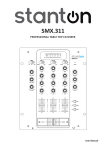


![PLAS A O ]-OR](http://vs1.manualzilla.com/store/data/005852706_1-5db0b7ed584537f0e62af161fb124638-150x150.png)
